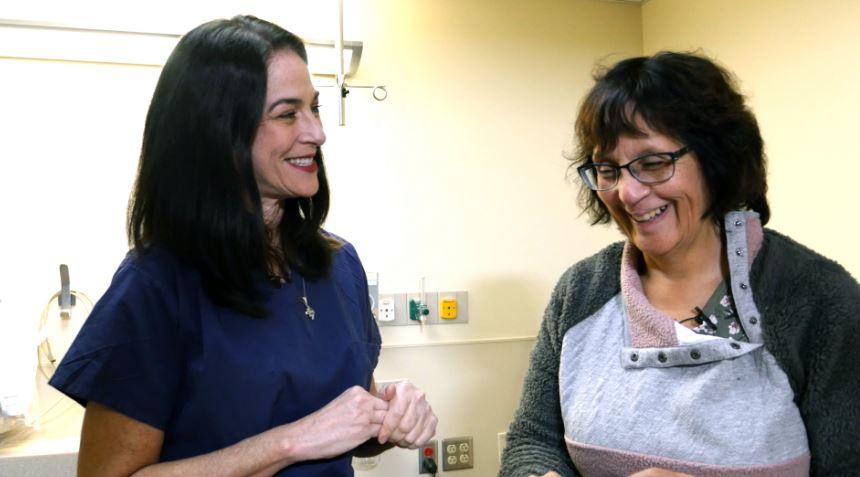
New treatment option for patients dealing with incontinence
A neuromodulator acts as a “pacemaker” for the pelvic zone, explains surgeon Suzzette Sutherland.Lupe Thompson is the go-to mom in her tight-knit community of Ketchikan, Alaska.
Need a ride to the game? She’s there. Cookies for a bake sale? She’s on it. And always: She’s there on game day, regardless of the sport, to cheer on the home team.
“I was ‘Ketchikan’s 411’,” Thompson quipped on a recent visit to UW Medical Center’s Northwest campus. Thompson was referring to the phone number once used to get information, before the advent of the Internet.
But a years-long battle with incontinence took its toll. “This just changes your life,” Thompson said. “You don’t want to do a lot. You don’t want to go out. And there’s just so much you have to do to plan ahead of time.“
This fear caused her to feel disconnected with the community she so loved. Thompson, 58, suffered from both fecal and urinary incontinence. The grind of having to always be near a bathroom and pack extra clothes, wore on her self-esteem and social life until she was motivated to take action.
Her primary care provider referred her to Dr. Suzette Sutherland, associate professor at the University of Washington School of Medicine and UW Medicine’s director of female urology. In Seattle, Thompson received a therapy called sacral nerve stimulation, which involves implantation of a small flash-drive-sized electrical generator under the skin in her upper buttock. This small generator sends a signal down a thin wire that, in turn, stimulates the pelvic nerves leading to the bladder, bowel and pelvic floor muscles.
When talking to patients, Sutherland describes the device as a “pacemaker” for the pelvic nerves. It “quiets down” the bladder and bowel and restores normal function. The technology, called neuromodulation, has been used to treat pelvic disorders for over 20 years.
Thompson was the first patient in Washington to receive a new version of this technology, made by Axonics. This version is rechargeable and lasts approximately 15 years after implant. Prior models would have to be surgically replaced every three to five years. The implanted generator also is much smaller; about the size of a quarter. And it is MRI-compatible.
“The advantage is that patients don’t have to have the device surgically removed before getting an MRI, only to have the device surgically reimplanted thereafter. Needless to say, the associated cost, time, and inconvenience to the patient represented a real burden,” Sutherland said.
Talking about incontinence – fecal or urinary – is taboo for many patients. But both urinary and bowel incontinence are common problems that can devastate one's quality of life. According to the Centers for Disease Control and Prevention, more than half of men and women over age 50 struggle with some degree of incontinence. The AARP estimated that more than 50% of women suffer from urinary incontinence. In spite of this, many patients think they must live with their condition – a point that frustrates Sutherland.
“We know there is a very high percentage of patients simply not seeking treatment. We are treating just the tip of the iceberg,” Sutherland said. “We see commercials, with celebrities, talking about ‘the freedom that living with pads provides’. Why live in pads when there are simple, reliable treatments available which will get you out of those pads?”
Getting the word out about treatment options such as this is a priority, she added.
So far, two months later, Thompson is doing well and has reclaimed her role as one of the “411s of Ketchikan.”
Downloadable media assets:
- Broadcast package with track (1:39)
- Broadcast package without track (1:39)
- Script (doc)
- Audio-only soundbites
- YouTube (1:42)
– Barbara Clements, 206.221.6706, bac60@uw.edu
For details about UW Medicine, please visit https://uwmedicine.org/about.
Tags:incontinence
